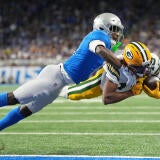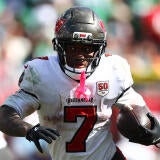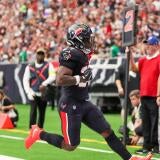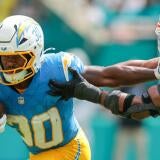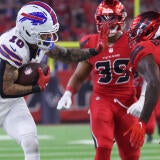Fantasy Football: Marquise Brown traded to Cardinals, boosting Rashod Bateman's value in Baltimore
The Ravens moved on from their former top wideout, opening up opportunities in Baltimore, while Brown joins a crowded mix
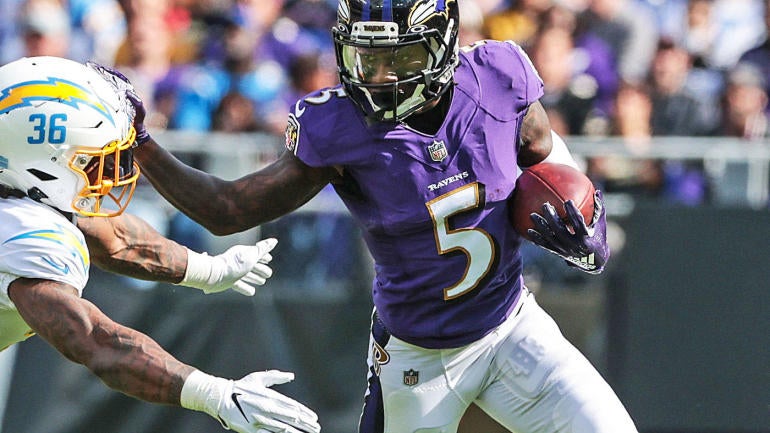
The Ravens had to make a choice on Marquise Brown: continue to deal with the nagging injuries he kept incurring, along with the occasional mistakes he would make on the field, or move on from him.
They chose the latter. Brown is headed to the Cardinals as part of a draft-night deal that included Arizona's first-round selection.
And Fantasy managers should actually be much happier for it.
Following the trade, Cardinals coach Kliff Kingsbury told the media the Cardinals "see him kind of taking over where Christian (Kirk) was," inferring that he'll spend a lot of time manning the slot, but Kingsbury mentioned twice how Brown could line up inside or outside, and both Kingsbury and general manager Steve Keim repeatedly referenced Brown's ability to be a vertical threat and his past history not only with Kyler Murray at Oklahoma, but in this style of offense.
In these ways, it's a big-time fit. Murray was one of the league's best deep-ball passers last year with a fifth-highest 51.3% adjusted completion rate and nine touchdowns of throws traveling at least 20 Air Yards (tied for fourth-most). The Cardinals also made a clear choice to attack deep more often as DeAndre Hopkins, Kirk, A.J. Green and even Antoine Wesley each finished inside the top-30 among qualifying receivers in percentage of total targets of 20-plus Air Yards, per Pro Football Focus. No other team came close.
Using Brown as a deep threat makes obvious sense and pairing him with a better deep thrower makes him appealing. Over the past two seasons, Brown has seen 61 targets of 20-plus Air Yards but caught just 16 and dropped four others. It suggests that Lamar Jackson didn't do a great job throwing accurately, and his adjusted completion rates of 40.7% in 2021 and 43.1% in 2020 on deep throws over the past two seasons corroborates that.
What Brown gains on deep throws helps his Fantasy status. It's what happens everywhere else on the field that hurts him. He joins an offense that's got a trio of reliable veteran pass-catchers (Hopkins, Zach Ertz, A.J. Green), a second-year receiver who is a YAC machine (Rondale Moore) and a running back who wound up taking much more work than anticipated last season (James Conner). When the Cardinals move into the red zone, Brown might not even be the fourth option -- Murray could either hand off, throw to one of his other, larger targets, or run it in himself. Since 2020, Brown has seen 26 red-zone targets, catching 15 of them for seven touchdowns with only two in 2021. Just last year, Hopkins saw 14 red-zone targets in 10 games and Ertz had 14 in 11 games with the Cards.
"When we have (all our receivers available), that's when we're at our best," Kingsbury said.
The fear is that Brown, even with a better quarterback, falls into a different type of role in Arizona's offense compared to when he had 29.1% of Oklahoma's target share in 2018. He might become much more big-play reliant, which would then lead to inconsistent Fantasy production. The 9.1 targets per game he has with the Ravens figures to dwindle as long as Hopkins is on the field -- Kirk averaged 5.0 targets per game when he played with Hopkins. Brown might settle in no higher than 6.5 targets per game, which means 111 targets over 17 games. That's good, but not amazing.
Brown's track record has also been spotty. He's had two great half-seasons: In the back-half of 2020, including the playoffs, he caught 37 passes for 534 yards and six scores on an average target depth of 11.1. Then in the first nine games of the 2021 season, he caught 52 passes for 719 yards and six scores on an average target depth of 13.4. Pretty much everything else has been a disappointment, including the second-half of 2021 when he was still fed targets in Baltimore even after Jackson got hurt, but did nothing with them.
My first reaction was to sink Brown, but I've thought a little more about the fit and I view him more as a usable No. 3 Fantasy boom-or-bust receiver who will probably bust a little more often than boom. He's worth a Round 7 pick whether catches count or not. His arrival hurts Moore and Ertz's upside since he should see more targets than they do on a regular basis, basically turning Moore into a late-round flier (and maybe an insurance policy for Brown) and Ertz into a low-end tight-end starter to begin the year.
But there are serious opportunities available in Baltimore. Mark Andrews was already presumed to be the squad's top target-getter. That's definitely not changing now. But what is changing is Rashod Bateman's role as their Ravens' top wideout. With Brown gone, Bateman could see as many as 110 targets (same range as Brown) but be given more chances in the red zone because of his ability to quickly separate as well as catch contested passes. It's a step up for him, putting him just behind Brown as a low-end No. 3/high-end bench Fantasy receiver.


